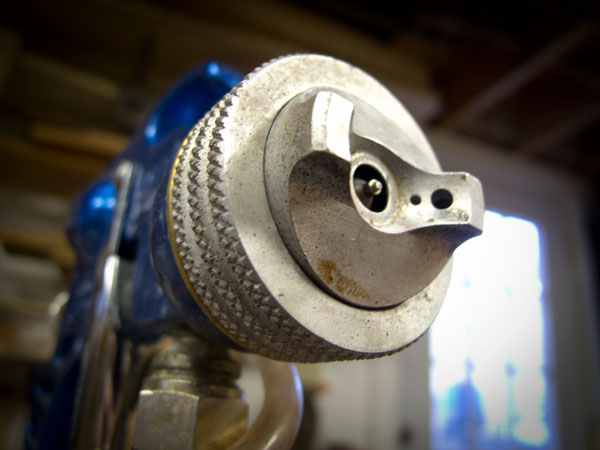We may receive a commission when you use our affiliate links. However, this does not impact our recommendations.
Every time I purchase lacquer at a professional paint store, I have the following conversation.
Me: “Could you put that gallon in the paint-mixing machine for a couple minutes? That will save me some time.”
Employee: “I’ll do it, but you won’t like it. You’ll create bubbles in the finish.”
Me: “I’ll risk it.”
I’ve been taking this risk for more than 15 years, and I have yet to have a single problem with lacquer, or really any finish. During my time at Popular Woodworking Magazine, I am most grateful for the education I received from editing and reading Bob Flexner’s columns.
He has dispelled more myths and stuck a fork in more misperceptions than any other modern woodworking writer I can think of. Flexner’s biggest strength is that he takes nothing at face value. He refuses to simply repeat “conventional wisdom” until he has tested it out himself.
More times than not, that wisdom turns out to be mistaken.
1. You have to finish both sides of a board. Bunk.
2. You can’t apply a film finish over linseed oil. Bunk.
3. You should never shake a can of film finish. Double-bunk.
I could go on and on, but Bob has done the job for you in his columns in Popular Woodworking and his excellent books.
I won’t lie: Bob can sometimes come off as a bit abrasive or sound like he’s on a crusade. He’s actually a sweet guy. He’s willing to change his mind. And most importantly – he is on your side. He doesn’t represent wood finishing companies and he cannot be muzzled.
This morning I’m applying some shellac and lacquer over a cured oil finish and can’t help but think of the guy and how he has made finishing a straightforward process with the minimum voodoo.
If you don’t have his books, you can rectify that at ShopWoodworking.com. “Wood Finishing 101” is a great place to start. “Flexner on Finishing” is the next step. “Understanding Wood Finishing” is his best book.
— Christopher Schwarz
Here are some supplies and tools we find essential in our everyday work around the shop. We may receive a commission from sales referred by our links; however, we have carefully selected these products for their usefulness and quality.








On one of my most recent paint spray purchases the woman helping me said that even when shaken on their machines the lacquer needs to be stirred to get a complete mix. Sure enough when I got home and checked there was still a layer of solids at the bottom of the can that hadn’t mixed. Stirring did the rick. I’ve had this happen before and found that when you don’t stir a satin finish, you get a glossy finish, since your leaving all the matter that is added to create the satin look at the bottom of the can. Shaking just doesn’t always get it, so be safe and always stir !
Re: myth about finish on both sides of a board. Help me understand where I went wrong tonight. I built a 6 board chest and finished the outside with 2 coats of commercial milk paint. Chest sat idle & completed for about 2 weeks now. Tonight I applied a 1 pound cut single coat of shellac (made 2 nights ago w/dewaxed tiger flakes) to interior for protection and the lid cupped so fast I could hear the battens straining the cut/clinched nails holding them on. The lid is 3/4″ pine and was 2 boards I edge glued together.
Why is this happening & where did I go wrong?
I sold paint for many years. There was a time when ‘high quality’ meant ‘really thick’. A paint that rhymes with glide on comes to mind. Some of the stuff was so thick the air bubbles couldn’t escape for a long time. I’ve been out of the game for a while, but all the leading brands I’m familiar with don’t sell the cottage cheese style paint these days (except for texture paint for the purists in the crowd).
Shaking the can certainly does aerate the paint. However, simply stirring slowly for a minute or two is quite sufficient to remove most of the bubbles. Advice I use and give is to just turn the can upside down the night before you use it. A cursory stirring is all it really needs when you open it the next day.
I have never seen any problems with atomized paint coming out of a spray gun when the source has been shaken, stirred, or stared at crossly.
If anyone is on the West coast (left coast?) check out William Ng’s school. Brian Miller teaches a finishing class there. He is on Bob’s level of expertise (they are friends and frequently coorespond from what I hear) You will be amazed at what you learn.
Dan
“…..Bob can sometimes come off as a bit abrasive…..’
The only time that’s been a problem is when Bob’s talking about sandpaper.
Otherwise, I really appreciate his wisdom and experience.
the fact is that oil based stains sold at most paint stores are …wait for it…. linseed oil! And suprisingly, you dont need to wait overnight for it to be dry enough to spray over, assuming you wipe on/wipe off as per the directions on the can.
Chris,
The spray gun looks just like my Earlex 5500 unit. Is that what you have? If so are you happy with it? I’ve used it some with WB laquer finishes and don’t feel like I’m really great with it yet. Still learning.
I’m guessing that you use solvent based laquers if you buy them at a paint store.
Excellent points.